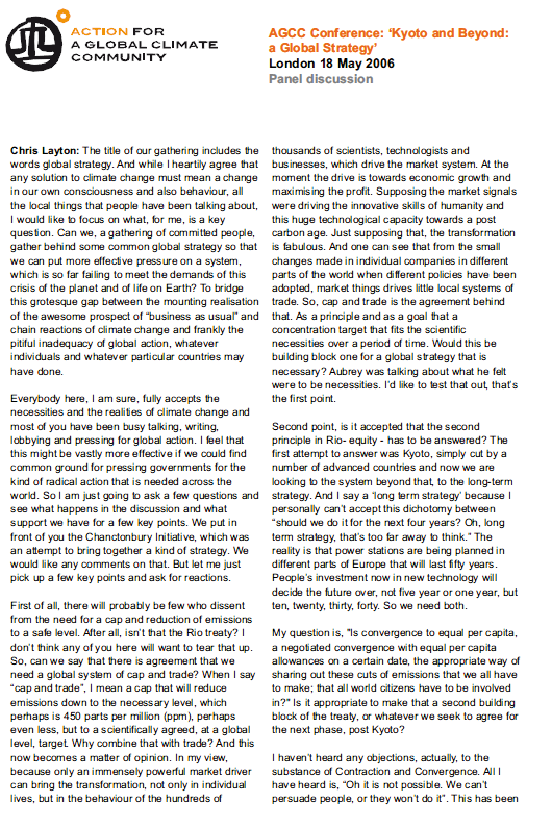Brazilian Gylvan Luis Meira Filho is an old friend. He was one of the key people, who had been the principal architect of the Brazilian Proposal [BP] introduced to UNFCCC in June 1997, in the run up to COP-3 Kyoto in December that year.
He knew very well about C&C as it had been introduced in June 1996 at COP-2 when he was the head of the Brzilian delegation.
He also knew that I'd been in DC at the invitation of USG to discuss C&C, prior to going to Beijing in July 1997 to discuss it further.We spoke together about C&C and his 'Brazilian Proposal' at the negotiations in Bonn that August.
He drew attention to 'the triple-integral' in the BP - namely the West's responsibility for the rise in: -
- PPMV
- Temperature
- Sea Level Rise.
I told him that I'd been in Washington DC in June and listened first-hand to US reaction to BP which was, "its more of the same old s**t . . . "
I said I thought the reaction was harsh but that BP wasn't a strategy so much as a protest. He referred to the Byrd Hagel Resolution of the US Senate of June 1997 and said, "two can play that game."We know the next bit of the history, we got a Kyoto Protocol that the US never ratified. But eight years later, at a Government conference on this very issue - C&C & the BP - in Sao Paulo in 2005, Luis said: -
“Actually, it is Contraction and Convergence that makes better sense; the logic holds better”.
Others approaches can be found in the literature, like the “Grandfathered Proposal” based on a hybrid per capita accountability; the “WRI’s carbon-intensity related proposal”; the “Argentine proposal for index-linking targets to GDP”; the “Triptych Proposal” of University of Utrecht; the “Contraction and Convergence Proposal” of GCI – Global Commons Institute; the “Increasing participation/Multistage approach Proposal”; and others: - The Brazilian Proposal and its Scientific and Methodological Aspects 2001
WORLD BANK ON C&C AND THE BRAZILIAN PROPOSAL
“Two approaches that are receiving significant attention are Contraction and Convergence [C&C] and the “Brazilian” Proposal. Contraction and Convergence is a science-based global framework whereby total global emissions are reduced (i.e., contraction) to meet a specific agreed target, and the per capita emissions of industrialized and the developing countries converge over a suitably long time period, with the rate and magnitude of contraction and convergence being determined through the UNFCCC negotiating process. It applies principles of precaution and equity; principles identified as important in the UNFCCC but not defined.The proposal by Brazil, which is based on cumulative historical emissions and their impact on the increase in global mean surface temperature, aims at sharing equally the burden of mitigation among all countries, industrialized and developing.”
GCI COMMENT ON C&C AND THE BRAZILIAN PROPOSAL
“A Unifying Strategy based on the merger of these two approaches, resolves the issue of ‘historical responsibilities’ with the future consumption patterns of fossil fuels and carbon pollution entitlements that can be designed to avoid dangerous rates of global warming and climate change.”
Under the chairmanship of former President Cardoso, an audience of around 100 people from the Brazilian Government gathered to listen to the debate between Miguez for the 'Brazilian Proposal' [BP - Author Luis Gylvan Meira Filho had retired from Government service at this point] and Aubrey Meyer for 'Contraction and Convergence' [C&C]. BP is essentially the precursor that led to the protest of the Kyoto Protocol while C&C is the strategic proposal for UNFCCC-compliance.
After an hour of presentations and debate, President Cardoso turned to BP author and veteran climate negotiator Luis Gylvan Meira Filho for a judgement: - after a long silence Luis said, "Aubrey is right."
GCI in Sao Paulo Brazil 26 27 July 2005
Hosted by Action for a Global Climate Community Observatorio de Clima Forum Paulista EAESP
In Brazil, where Aubrey and I attended, actually, the first public debate, on the whole issue, where the Brazilian historical proposals were put up and Aubrey argued his point. It was fascinating, that debate, and one of the key people, who had been one of the architects of the Brazilian proposals [Gylvan Luis Meira Filho], at the end said, “actually, it is Contraction and Convergence that makes better sense; the logic holds better”.
Peter Luff AGCC Convenor
Panel Discussion 2006



